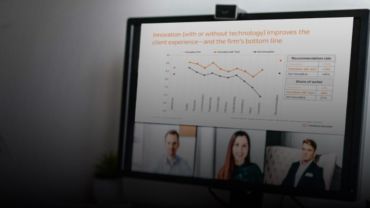It's the user-friendly legal design of the platforms, not the legal technologies that underpin them that best enables citizens to access the justice system
Charles Dickens’ Bleak House begins in the legal world — at the Lincoln’s Inn in London. Smoke rises from the chimneys, mixing with waterside pollution as well as a dense fog. Everything around the place is indistinguishable and murky. In the heart of this fog sits the Lord High Chancellor in his High Court of Chancery with a “foggy glory” around his head. A score of wigs sits beside him, deeply engaged in “ten thousand stages of an endless cause, tripping one another up on slippery precedents, groping knee-deep in technicalities.”
Here, Dickens paints a common caricature of an opaque, unclear and inaccessible justice system.
This caricature has existed for hundreds of years, and it continues its relevancy as the legal system is still widely perceived as aloof, overly complex, and utterly inaccessible. Lately, however, access to justice (A2J) has become an increasingly hot topic in the legal world, even before the COVID-19 pandemic and more certainly since. New digital technologies that can “address the 86% of civil legal problems reported by low-income Americans that aren’t fully resolved” have been actively discussed.
The problem, however, is not purely American. Just 46% of the world’s population lives under the protection of the law, and even in some highly developed countries, access to justice has decreased, according to the Organisation for Economic Co-operation and Development (OECD). Indeed, in the 1980s, a full 80% of households in England could pay for legal aid; but by 2008, that number had dropped to 29%, notes the OECD.
The economic side of A2J
The overall debate on A2J has mainly focused on the economic side of the problem, which holds that the primary reason people go without legal representation is that they cannot afford it. Modern technologies have been suggested as the best solution because an automated legal processes would be cheaper more efficient, which would result in more resolved cases in less time and cost, potentially driving down the overall cost of legal services and boosting realizations rates.
This certain is one part of the problem; however, as the Dickens example shows, another significant part of the A2J problem is the lack of transparency and the opaque nature of the legal system. People are alienated and often don’t know how to approach it. Much of this is perfectly natural — the law must be complex to be flexible, and sometimes lawyers express themselves with bureaucratic gobbledygook in order to be precise.
That doesn’t mean, however, that a nation’s legal system should simply give up on being accessible to the majority of its citizens.
Digital technology provides easier access
Digital technologies can make the legal system more approachable. In fact, they already have — you can read actual laws, regulations, and codes for free on the internet — and finding basic answers to simple legal questions online has empowered the legal consumer tremendously.
Now, legal consumers can also find useful contract templates for free or use question-based contract drafters to assemble their own documents. In his latest book, legal futurist Richard Susskind also argues convincingly that digital court systems could solve disputes quicker, at a higher standard, and with reduced cost to the taxpayers. Digital, intuitive, and jargon-free interface platforms could make the legal system more welcoming to its most common users, especially as the current global pandemic makes physical court rooms literally inaccessible.
Further, artificial intelligence that helps legal consumers predict the outcome of their legal proceedings, access their legal position, formulate their own arguments, etc., offers a huge potential for democratization and consumer empowerment. However, these same technologies could also make the legal system even less transparent if they are not leveraged correctly.
First, decisions made by closed-source artificial intelligence could make legal decisions even more opaque. The racist bias that was unfortunately part of the COMPAS algorithms used in criminal sentencing guidance showed how legal AI can make the law more confusing and unjust. Second, digital technologies can make the legal system feel even more unapproachable if not designed with the end-user in mind. If, for example, the end-user does not understand how to work with the applied technologies, then the technology will work as yet another fence that makes it harder for the legal consumer to comprehend and access the system.
The point is that it is not the technology itself that enables A2J — it’s the design. Indeed, new technologies can empower the legal consumer only when the right design principles are applied as well.
User-friendly design is key
The aim of legal design is to make legal products that are intuitive and user-friendly, and that requires a user-centric approach that necessitates the collaboration and interaction of the end-user. To improve AJ2, legal-tech products should be client-facing and designed in a way that empowers laypersons to comprehend and improve their own legal situation. Again, this requires a well-designed interface that is informative and effective, yet simple to use while at the same time encompassing the most complicated legal implications.
That is not an easy task, to say the least, which is why the client-centric design principles are so crucial. The entire process must be grounded in the experience of the end-user with the final goal of delivering them value. Therefore, all the relevant stakeholders must be involved, and they must establish a productive feedback culture that must constantly test, iterate, and improve the product until it reaches the final state.
The current pandemic crisis is a digital ground zero, in a way. Now is the perfect time to build a new, accessible legal system with the end-user at its center. Law firms can increase their efficiency all they want, but if they don’t lower their prices or create new user-centric solutions, they will not improve the AJ2 and they will leave an increasing portion of their client base behind.
Clearly, client-driven innovation is the key. Likewise, court systems can leverage technologies to control and suppress their citizens; or they can use them to open the legal system to its citizens, making it cheaper and easier to understand. However, no matter the innovative technologies utilized, they alone will not solve A2J inequity if there is not a user-centric motivation behind it.
It is legal design, not legal tech, that enables access to justice; and it’s legal design that will finally lift the fog that surrounds the current legal system.







